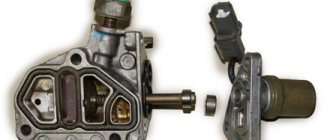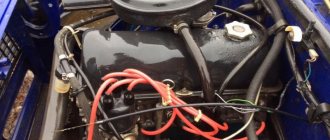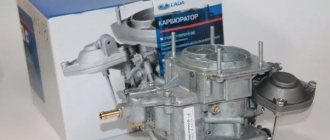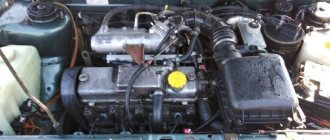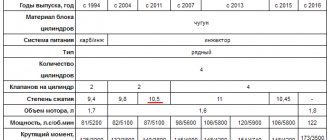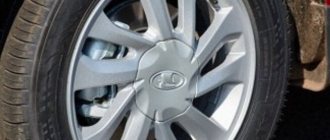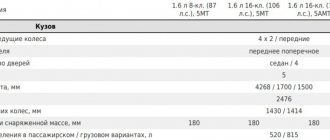AvtoVAZ is developing its 16-valve engines gradually, that is, step by step. When the updated Kalina family appeared in 2013, buyers were perplexed as to why they offered a 106-horsepower engine in manual versions, which differed little in design from the usual Priora engine.
The new engine was equipped with resonant supercharging, and it seemed that its presence would only have disadvantages: reliability was reduced, there was no way to connect the cable drive. But it turned out that the new engine was no worse than its predecessor: the mass air flow sensor often breaks down, and the DBP and DTV sensors almost never. There is no MAF sensor in the design of the 27th engine, which is the secret of increased reliability.
By the way, Lada Vesta with a Nissan engine is getting ready for release!
Motor 21129
It was with this version of the gasoline engine that AvtoVAZ presented the first Vesta six years ago. Here are some of its characteristics:
- fuel - gasoline;
- volume – 1.6 liters;
- power – 106 forces;
- torque – 148 Nm.
Today, such a motor is paired only with a manual transmission with five forward gears. But the robot boxes were left only for the Grant model. Many compare the 21129 motor with the 21127 motor, which is equipped with some Grants, some even come to the conclusion that this is the same engine, but despite the fact that they have a lot in common, 21129 has a number of modifications that cannot be ignored:
- modernized lubrication system;
- the oil sump received a larger volume and an aluminum design (in 127 there is a steel one);
- another option for the oil intake;
- For installation on vehicles on the B0 platform (Largus, XRAY and Vesta), the support fastening system has been redesigned.
To accelerate Vesta to hundreds, the engine will need a little more than 11 seconds. The maximum speed it will show is 182 kilometers per hour. And, if you believe the passport data, the fuel consumption of Vesta in this modification will be approximately:
- 9.3 liters in the city;
- 5.5 liters on the highway;
- about 6.9 liters with the combined version.
This engine is very popular not only in Russia, but also in the CIS countries. The whole point is in its comparative primitiveness; the engine, by modern standards, is technically very simple. Which makes its maintenance a simple and cheap process.
At the same time, it is very difficult to call it unreliable. Provided proper and timely maintenance, it will not cause any serious problems to the user, of course, if you use the car adequately and adhere to the basic recommendations of the manufacturer.
This engine is the best solution for a simple Vesta in a sedan. Its power is quite enough for the average user, and reliability and maintainability fully compensate for what the 1.8 liter engine can offer, and allow us to talk about a longer resource.
Fortune lottery
Any Vesta, regardless of its cross-country ability and body type, handles great. When it works.
Alas, as we have noted more than once, the quality is still poor. Even if there were not seven, but one hundred and seven Vests at the test site, we still would not be able to say with complete confidence whether the sedan handles better than the station wagon - and whether the elevated Cross is more exciting. Although the VAZ team, with the advent of Vesta, began to be more jealous of the stability of quality and quickly respond to criticism, the purchase still remains a lottery, aggravated by the fact that, for example, in Moscow, almost no dealer will let you ride in the cars that they have in availability.
Vesta's chassis is excellent: in serviceable cars, the top speed on the elk test is impressive (83-84 km/h), regardless of body type
Of our Wests, only three had a fully serviceable chassis, and the main thing here was to be lucky with the rack and electric booster! Then the steering wheel will delight you with its excellent reactive action. The most unpleasant thing is that no one will replace a faulty electric booster or a “pinched” rack, which usually manifest themselves by “biting” the steering wheel, under warranty: dealers will consider them absolutely in good working order. It is not uncommon for the wheel alignment angles to be carelessly adjusted, which is why Vesta can turn, for example, to the right more readily than to the left, lose stability in a straight line, or even become prone to skidding. It happens that everything happens at once. Fortunately, these ailments can still be treated with proper adjustment.
Due to the fact that Vesta willingly splashes water from under the wheels onto the windshield and into the engine compartment, it is better to avoid speeding through deep puddles. Owners of cars with AMT should be especially careful: moisture gets into the poorly protected sensor connectors on the box - and the electronics may generate an error
| Prices and configurations of Lada Vesta (sedan) cars | ||||
| Equipment | 1.6 MT | 1.6 AMT | 1.8 MT | 1.8 AMT |
| Classic | 584900 | — | — | — |
| Classic Start | 609900 | 634900 | — | — |
| Comfort | 637900 | 662900 | 672900 | 697900 |
| Comfort Image | 660900 | — | 695900 | 720900 |
| Comfort Multimedia | 665900 | 690900 | — | — |
| Luxe | 700900 | 725900 | 735900 | — |
| Luxe Multimedia | 728900 | 753900 | 763900 | 788900 |
| Luxe Prestige | 746900 | — | 781900 | 806900 |
| Exclusive | — | — | 814400 | 839400 |
Motor 21179
For those who want to get better dynamics, or for those who are considering purchasing a version of the SV Cross, which is heavier, it is better to consider the motor 21179 , which has the following characteristics:
- fuel - gasoline;
- volume – 1.8 liters;
- power – 122 forces;
- torque – 170 Nm.
Let's look at some passport numbers from AvtoVAZ for this engine, however, they may vary depending on which version of Vesta it is installed in. The engine accelerates to 100 km/h in an average of just over 10 seconds. The engine shows maximum speed at approximately 186 kilometers per hour. Average consumption:
- city - 9.5 liters;
- highway - 6.2 liters;
- combined mode - 7.4 liters.
The power unit is also paired with a five-speed manual transmission, however, here the manufacturer decided not to use its own gearbox, but to install an option from Renault-Nissan.
This is the first engine of a domestic manufacturer to feature a mechanism for adjusting valve timing, with a phase shifter installed only at the intake. And in order for everything to be lubricated more efficiently, a Korean oil pump from GMB .
The cooling system also received a pump from this company. All this made it possible to achieve more power and lower gasoline consumption, and also improved a number of other indicators. However, this also brought some disadvantages, since Korean options are several times more expensive than Russian ones.
Version 21179-77
Modified version for Vesta Sport. It differs as follows:
- another intake;
- new camshafts;
- more efficient injectors;
- redesigned gas exhaust system.
Lada Vesta engine life - you need to know
Life tests of the units installed on Vesta allow us to say that the overall impression of them is rather good.
We have already mentioned what resource the factory installs in the description of each motor; here we will briefly write:
— VAZ 21129 resource — 200,000 km; — motor life of the VAZ 21179 engine is 300,000 km; — resource hr16de from Nissan — 250,000 km.
Tuning is available in a wide variety of designs. Excellent options for tuning measures to improve driving characteristics would be the installation of a lightweight crankshaft and forward air flow. You can install an additional turbine; after modification, you need to improve not only the engine, but also other components of the car.
The main malfunctions and ways to eliminate them are:
1. An unpleasant whistle under the hood - most likely the timing belt has stretched and is close to breaking. It is better to replace if possible;
1.1 Unpleasant bubbling noise under the hood - the hr16de chain may have stretched and requires attention; 2. The engine stalls regularly for no apparent reason - a likely scenario is that the relay in the ignition unit has failed. It can be repaired during a recall campaign for defective vehicles; 3. At medium speeds, a characteristic nasty sound occurs - the gasket in the exhaust pipe has burned out or is burning out. Replacement is easy, especially if you contact the ASC; 4. The appearance of such a phenomenon as vibration - in VAZ engines this is a design flaw associated with the right airbag. Replace and the problems will disappear.
5. Increased fuel consumption, unstable operation, sluggish acceleration from more than 15 to hundreds - the oxygen concentration sensor (lambda probe) may be broken.
Motor H4M
This is a joint development between Nissan and Renault. Nissan calls the engine HR16DE , and Renault calls it H4M . AvtoVAZ also uses the name from Renault. Main characteristics:
- fuel - gasoline;
- volume – 1.6 liters;
- power – 113 forces;
- torque – 152 Nm.
The gearbox is a Japanese-made JF015E from Jato. Among the features of the motor relative to Russian engines, the following main points can be highlighted:
- timing chain drive;
- aluminum cylinder block;
- solid cast iron sleeves.
With proper maintenance, the engine will last 250 thousand. This engine is quite popular and has mostly positive user ratings. Its main disadvantage is that its maintenance will cost more than engines from VAZ.
Sedan or station wagon?
The question is more of a religious one.
On the altar of sedanophiles is an advantage in visibility to the rear (the rear window opening is larger, and it is not covered in dirt), an isolated luggage compartment and better acoustic comfort (in a station wagon there is more aerodynamic noise, including due to the roof rails). The sedan is 42 kg lighter, thanks to which it reaches 100 km/h half a second faster, and it is 0.2-0.3 l/100 km more economical in our ARDC cycle, which simulates real driving in Moscow and the region. And it is for the sedan that VAZ offers the widest choice of trim levels: the most affordable Classic version and the most expensive Exclusive version are not prescribed for station wagons. The full version is available only to subscribersSubscribe now
I'm already subscribed
Installation of alternative engines on Vesta
Equipping the Lada Vesta with other engines is not yet widespread. This car has not yet become a cult car, like, for example, the Lada Priora. There is no detailed information about how and what power plants can be installed instead of the standard ones. This topic remains at the theoretical level for now. Basically, as the most affordable method, it is proposed to install a turbine; moreover, this is the most budgetary tuning option that can increase power and dynamic characteristics without the need to completely replace the engine. The design features of Vesta are similar to Lada Priora, so theoretically it is possible to install different engines, for example, from Mazda, Honda, or Ford Focus. If everything is more or less clear with the choice, many nuances should be taken into account when making such substitutions:
- Installing an alternative motor will require much more financial investment than the same procedure with installing a standard unit.
- If you have the opportunity to buy a higher-class car, it is better to buy it than to spend even more on installing an engine under the hood of a budget car.
- Replacing the motor will require replacing the brake system and other elements.
- The project requires not only financial investments, but also a lot of free time.
- Without the appropriate knowledge, skills and experience, the project is doomed to failure.
- One cannot cope with such work alone.
Engines on Lada Vesta satisfy any requirements of motorists. In fact, for the first time, a Lada car receives a whole line of power units from the weakest to the most powerful; a foreign-made unit has appeared. Engineers also announce the possibility of installing a diesel engine, but when this will happen is unknown. The diesel engine is more economical, which means it will be very popular in Russia. This will be the first diesel engine in the history of AvtoVAZ.
We recommend reading:
- Does a Lada Vesta car owner really need car chip tuning and which one?
- Modern Lada Vesta or modernized Renault Logan?
- The domestic Lada Vesta car still needs rear mudguards
- Selecting and changing oil on Lada Vesta
- Gearbox for Lada Vesta: structural features and repairs
- Lada Vesta bumper: methods of dismantling and increasing protection of parts
